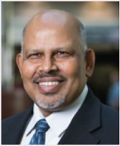Minneapolis-St. Paul Int’l Breaks Down Language Barriers

As executive director and CEO of the Metropolitan Airports Commission, Brian D. Ryks, A.A.E., is responsible for the administration and management of Minneapolis-St. Paul International and six general aviation airports. Previously, he held similar positions at Gerald R. Ford International Airport in Grand Rapids, MI, and at St. Cloud Regional Airport in Minnesota. Ryks serves on the board of directors for the American Association of Airport Executives and Airports Council International-North America (ACI-NA). He is chairman of the ACI-NA Audit Committee and serves on the organization’s World Governing Board. |
Like many large airports, Minneapolis-St. Paul International (MSP) is a global facility—not only in terms of its air service destinations, but also in terms of its workforce.
The Twin Cities area has a very large immigrant community, particularly from Southeast Asia and Africa, especially Somalia. More than 23% of MSP’s 19,000 badge holders were born outside the United States. They perform many vital functions throughout the airport, in leadership and administrative roles, ground services, passenger services, janitorial services, concessions, security and many other jobs. Often, they are on the front lines helping customers by providing food and retail services or wheelchair assistance.
Last year, participants in MSP’s broad-based Customer Service Action Council discussed barriers to recruitment and retention of airport workers. Language barriers were cited as challenging for airport workers and the customers they serve. How could we help employees overcome those workplace barriers and at the same time improve services to customers?
The answer came via a partnership with the Ronald M. Hubbs Center for Lifelong Learning, a local adult education facility that provides classes to help participants improve basic skills, earn a GED, prepare for employment or learn English. We worked with the Hubbs Center to begin offering English as a Second Language (ESL) courses to MSP workers at no cost to the employees or their employers. The Metropolitan Airports Commission covers the cost as a way of helping concessionaires and other MSP businesses attract and retain employees and improve services to our customers.
An instructor from the Hubbs Center presents ESL classes on-site at the airport, making it simple and convenient for employees to participate. MSP’s light rail connection to downtown Minneapolis and downtown St. Paul makes it easy for residents who don’t speak English to work at the airport and participate in the language classes.
Employees who enroll in the 14-week program complete coursework online and meet in person weekly. The first course began in October 2018 and was attended by 12 employees. As word spread about the program, 20 employees signed up for the second session, which ended in June. In both cases, we held ceremonies to honor the achievements of program participants.
Based on feedback from program participants, we have increased class length from two hours per week to three, and have further strengthened the in-class learning opportunities.
In July, we began offering two courses simultaneously, Workforce English I for beginners and Workplace English II for more advanced ESL employees. We advertised the new sessions throughout the airport campus in several languages, including Amharic, Somali, Hmong, Spanish, Oromo and English.
Looking forward, we will continue to work with participating employees and their employers to assess and improve the program.
Customer service is a shared obligation at airports, and the best way to ensure a consistent, positive experience for travelers is for airport partners to work together to define shared service goals and approaches. The Customer Service Action Council is where that partnership takes shape at MSP, and you can see results throughout the airport campus. The current investment in English language training for employees is just one of its recent efforts.
Like other large airport operators, we invest billions of dollars in infrastructure, and we work to ensure our facilities are safe, attractive and efficient, and also reflect our community. But the best facilities in the world won’t make an airport great if the workers don’t have the tools they need to connect directly and effectively with passengers.
Our ESL program recognizes the power of bringing together diverse cultures, and it provides the language skills some employees need to build thriving careers and provide the level of service customers expect. By embracing and reflecting our community, we differentiate MSP from other airports, give travelers a true sense of Minnesota and help make it a place people want to return to again and again.
FREE Whitepaper
Fairbanks International Airport Baggage Transport Conveyor Enhanced With Mod Drive™ System
Airports face a host of unique industry challenges, such as meeting efficiency regulations and seeking out the best maintenance practices to reduce costs and keep operations flowing. In today’s current economic climate, any potential cost savings can go a long way.
In 2019, Alaska’s Fairbanks International Airport (FAI) sought to modernize its equipment and operations. They were dissatisfied with the performance of the gearmotors on their baggage transport conveyors and began searching for new suppliers. Regal approached FAI with a solution that could improve equipment performance and simplify maintenance, with the added benefit of energy cost savings: the Hub City® MOD Drive™ system.
This white paper discusses the hardware deployed, the test results and the annualized expectations for ROI.
Recent Industry Insider columns
- A Bittersweet Goodbye
- Cyberattacks on the Aviation Sector: Threats, Trends and Strategies
- Empathy is Key to Effectively Working with the Media
- Carbon Capture, Utilization and Sequestration: An Environmental Gold Mine for Aviation?
- Now is the Time for Los Angeles to Lean Into its Aviation Legacy and Shape the Future








